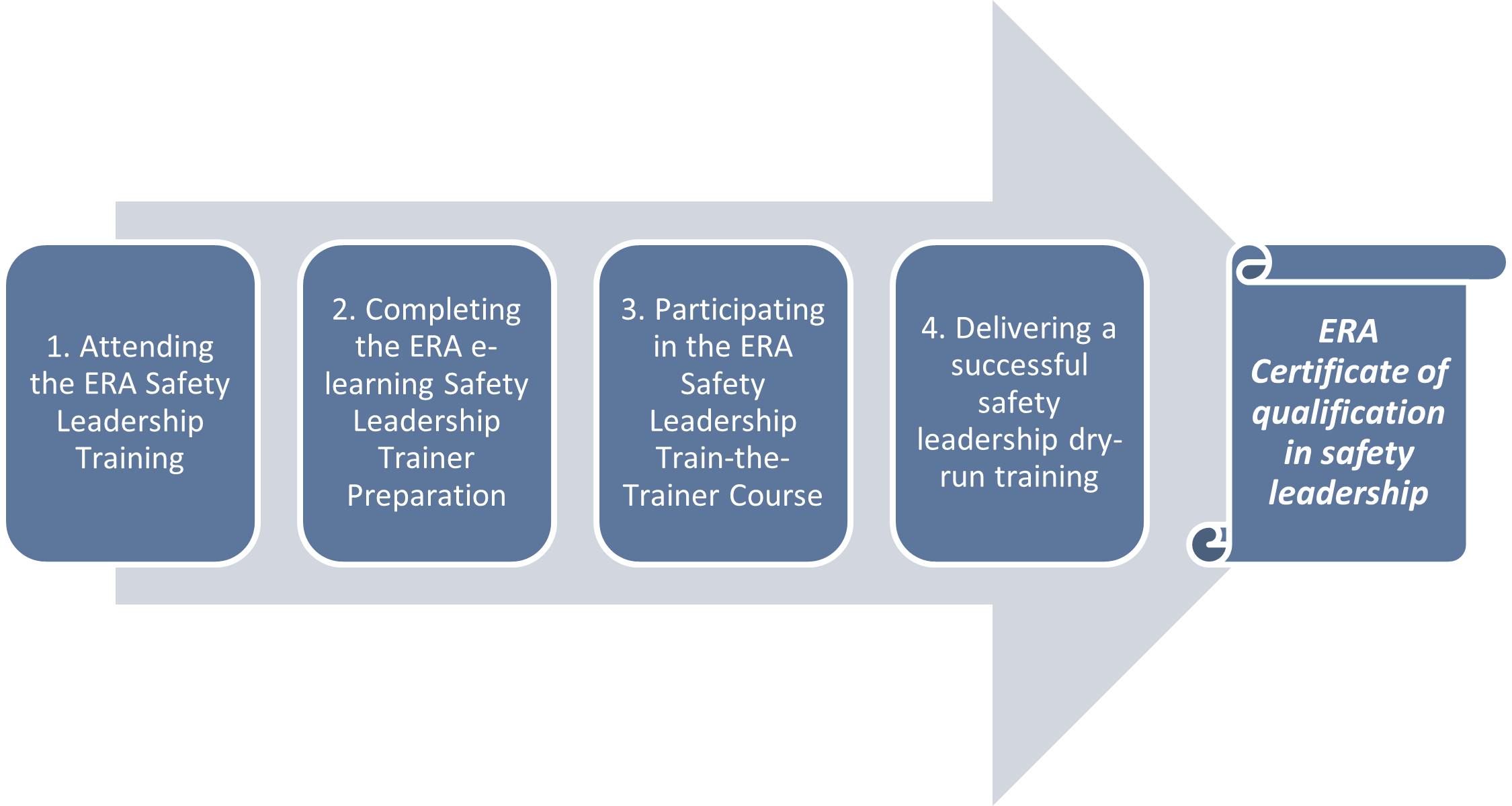ERA is qualifying external professionals willing to deploy safety training based on material developed and owned by ERA. This is part of ERA’s commitment to disseminate information related to the European Union framework of railway law to relevant stakeholders, and to enhance the application of the railway safety legislation by the individuals and organisations contributing to the railway system.
Qualification criteria, as well as rights and obligations applying to the deployment of ERA training material, depend on the topic.
The qualification path applying to the ERA Safety Leadership Training is detailed hereafter.
Safety Leadership Trainer Qualification Path
In any organisation, a culture for safety requires a daily commitment from managers at all levels. To foster a leadership for safety across the European railways, ERA is qualifying external professionals willing to deploy the ERA Safety Leadership Training.
The professionals wishing to obtain the ERA certificate of qualification in safety leadership shall fulfil the following eligible criterion and achieve the fourth steps of the qualification path, as described below.
Eligible criteria:
- 5 years of experience in railway operations or safety related activities in the railway sector or in any other high-risk domain.
- B2 Level in English is mandatory as the Train-the-Trainer course is conducted in English.
Advantageous attributes for acquiring the skills to deliver ERA Safety Leadership Training:
- Experience working with railway safety matters, system safety, event analysis.
- Knowledge and experience in HOF related methods and topics.
- Experience in delivering training or presenting in public.
- Great motivation to transmit a commitment to improve safety and achieve behavioural change through conveying humanistic values.
Additional information:
The ERA safety leadership training is co-facilitated by two trainers. This arrangement is important to master the logistical aspects, increase the quality of interactions with the participants, and ensure a fruitful training session. Consequently, ERA strongly recommends to any candidate to pair up with at least one colleague to engage in the qualification path. In particular, the dry-run training session (step 4 of the path) is designed to be prepared and performed by two candidates. However, the assessment of the dry-run conducted by ERA is done at individual level.

To understand how the training is composed and facilitated and start getting acquainted with the content, the candidate shall participate or observe a Safety Leadership training session performed by ERA.
To attend a session, the candidate shall register to any classroom session organised by ERA or request an ERA Corporate Training.
To acquire the basic knowledge related to safety leadership and initiate pedagogical preparation, the candidate shall follow an online preparatory training and complete all e-learning exercises. The exercises will be reviewed during the train-the-trainer course.
Estimated duration of the preparatory work: between 2 and 3 days.
As this step is a preparation to the ERA safety leadership train-the-trainer course, access to the ERA e-learning Safety Leadership Trainer Preparation is granted to the individuals who will register and participate in the ERA Safety Leadership Train-the-Trainer Course.
To get a detailed understanding of the training content and apprehend logistic aspects, the candidate shall participate in the train-the-trainer course, which is a three-day classroom training animated by ERA. It includes a break-down of the training components and didactical means, as well as practical rehearsal.
To attend the course, the candidate shall register to any classroom session organised by ERA or request a Corporate Training. Registration is subject to the fulfilment of the eligible criteria detailed above.
To obtain the ERA certificate of qualification in Safety Leadership, the candidate shall arrange and co-facilitate a safety leadership dry-run training. The dry-run training session is firstly prepared with the assistance of ERA (coaching mode), then observed and assessed by ERA against the following criteria:
- Concepts: how the candidate masters the theoretical parts and values of the training and can give practical illustrations based on experience.
- Didactics: how the candidate manages and conducts interactions with the training participants.
- Film: how the candidate is acquainted with the film ‘Between the Lines’ and masters the relationships with the training modules and objectives.
- Logistics: how the candidate masters organisation aspects (including selection and preparation of the room and equipment), time management, and the use of training instruments (including paperboards and workbook).
Coaching and assessment by ERA is a chargeable service provided by ERA to the organisation representing the candidates, which shall be framed by a contract.
ERA Certificate of Qualification in Safety Leadership
After the dry-run, constructive feedback is given to the candidates. If the assessment is positive, the candidate is granted with the ERA certificate of qualification in safety leadership. If the assessment is negative, additional coaching and observation will be required, as a chargeable service provided by ERA.
Successful candidates willing to deploy the ERA Safety Leadership Training will be invited to agree with the rights, obligations and conditions (under finalisation) associated with the use of the related training material owned by ERA. They will become part of a European community of professionals committed to enhance safety leadership across European railways.
Organisational Just Culture Train-the-Trainer
For NSAs or other organisations who wish to disseminate the Organisational Just Culture training, a Train-the-Trainer course can be organised.
After a dedicated training needs analysis, the train-the-trainer approach is based on a preparation on reference material, then on a series of exercises and individual coaching, followed by an internal dry-run and a final first case with personalised feedback.
